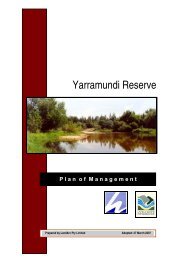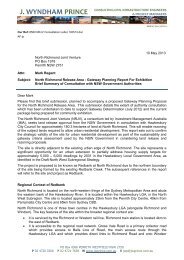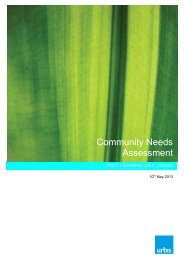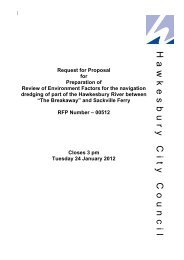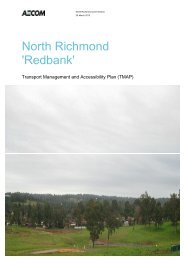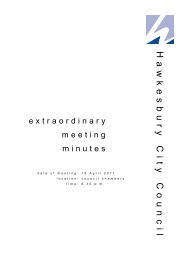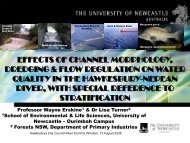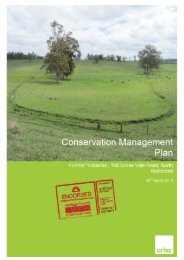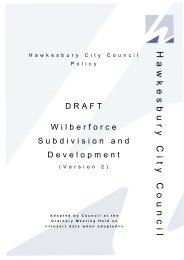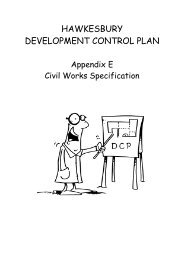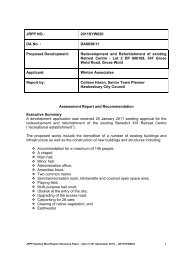Attachment 1 to Item 53 - Roadside Vegetation Management Plan
Attachment 1 to Item 53 - Roadside Vegetation Management Plan
Attachment 1 to Item 53 - Roadside Vegetation Management Plan
Create successful ePaper yourself
Turn your PDF publications into a flip-book with our unique Google optimized e-Paper software.
H AW K E S B U R Y C IT Y C O U N C IL R O AD S ID E V E G E T AT IO N M AN AG E M E N T P L AN<br />
6 <strong>Roadside</strong> <strong>Vegetation</strong> <strong>Management</strong><br />
<strong>Plan</strong> – Strategic <strong>Management</strong><br />
Actions<br />
6.1 ROAD SAFETY<br />
Adequate road verge maintenance is the key <strong>to</strong> ensuring that roads remain trafficable and safe. The<br />
following actions should be followed <strong>to</strong> ensure that a safe carriageway is provided. The road envelope<br />
consists of the lanes, shoulder, road verge and batter. The lands, shoulder and verge are <strong>to</strong> be devoid<br />
of vegetation. The batter is <strong>to</strong> be, while vegetation on the batter is not <strong>to</strong> be removed. It is imperative<br />
that these guidelines are followed strictly <strong>to</strong> ensure impacts on roadside vegetation are minimised.<br />
Intersections<br />
• Austroads has a number of guidelines/standards in relation <strong>to</strong> sight distances for different<br />
situations and sight triangles at intersections. Sight distances and sight triangles at<br />
intersections are <strong>to</strong> be managed in accordance with Austroad standards (Austroads 2009).<br />
Standards for adequate sight distance for different situations can be found in “Guide <strong>to</strong><br />
Traffic Engineering Practice” Published by Austroads.<br />
• Where vegetation removal is required, assessment as <strong>to</strong> whether the vegetation <strong>to</strong> be<br />
cleared is an EEC is required. If so further assessments will be required from DECCW and<br />
appropriate offsets may be required.<br />
Sealed Roads<br />
• On sealed roads, the road envelope will have a minimum vertical height of 5.5 m 1 except<br />
on designated high clearance routes where it will be 6 m (Austroads 2009).<br />
• The width of the road envelope will be from 500 mm on the outer side of the white road<br />
post, <strong>to</strong> 500 mm on the outer side of the white road post, on the other side of the road.<br />
This provides for two lanes each being 3.5 m wide, the shoulder being 1.5 – 2.0 m wide<br />
(depending on the volume of traffic) and the road verge width being 1 m (Austroads 2009).<br />
The batter will have a minimum width of 1 m and up <strong>to</strong> 6 m depending on the slope of the<br />
batter or if a greater sight distance is required (Austroads 2009) (Figure 3).<br />
• <strong>Vegetation</strong> outside of these clearance distances (heights and widths) should not be cleared<br />
or disturbed, unless a full assessment of their impacts are performed and approval given.<br />
Unsealed Roads<br />
• On unsealed roads, the road envelope will have a vertical height of 5.5 m (Austroads<br />
2009).<br />
1 Austroads (2009) does not provide clearance heights for vegetation. Hence the standard clearance heights for<br />
major roads and other roads have been adopted for clearance heights of vegetation.<br />
© E C O L O G I C AL AU S T R AL I A P T Y L T D<br />
46



